How to Set Up a Fishing Rod: A Comprehensive Guide
Setting up a fishing rod might seem daunting at first, but with a little guidance, it becomes a straightforward process. This guide will walk you through each step, ensuring you're ready to cast your line with confidence. We'll cover everything from choosing the right reel to mastering the art of line spooling.
Understanding Your Fishing Rod Components:
Before we begin, let's familiarize ourselves with the key parts of a fishing rod and reel:
- Rod: The main body, usually made of graphite or fiberglass, providing the structure for casting and fighting fish.
- Reel: The mechanism that holds your fishing line and allows you to cast and retrieve. There are different types – spinning reels, baitcasting reels, and spincast reels – each with its own setup.
- Fishing Line: The thread that connects your hook to your rod. The type and strength will vary depending on the type of fish you're targeting.
- Rod Guides: Small rings along the rod that guide the fishing line during casting.
- Reel Seat: The part of the rod that holds the reel in place.
- Handle: The part of the rod you grip for control.
1. Attaching the Reel to the Rod:
This step is crucial and differs slightly depending on your reel type.
-
Spinning Reels: Most spinning reels have a screw-on reel foot. Simply align the reel foot with the reel seat on the rod and tighten the screw securely. Ensure it's firm but not overly tight to avoid damaging the rod.
-
Baitcasting Reels: Baitcasting reels usually attach similarly to spinning reels, using a screw-on foot. However, ensure the reel is properly aligned with the rod's guides for optimal line flow.
-
Spincast Reels: Spincast reels generally click into place on the reel seat, requiring no screws or additional tools. Make sure it's securely fastened.
2. Spooling the Fishing Line:
This is where you load your fishing line onto the reel. Improper spooling can significantly impact your casting and overall fishing experience.
-
Prepare the Line: Tie the end of your fishing line to the arbor knot (the small spool inside the reel). Some reels have a line-tying loop for easy connection.
-
Fill the Spool: Slowly and evenly feed the line onto the spool, making sure it's tightly wound and there are no loose loops. Overfilling can lead to tangles, while underfilling can reduce casting distance and line capacity. Aim for a level fill, leaving a small amount of space at the top of the spool (about 1/8").
-
Secure the Line: Once the spool is full, tie a knot to secure the line. This helps prevent line slippage.
3. Tying a Fishing Knot:
Choosing the right knot is crucial for preventing line breakage. The best knot depends on the type of line and lure/bait you are using. Here are a few popular choices:
- Improved Clinch Knot: A versatile knot suitable for various line types and lures.
- Palomar Knot: Known for its strength and ease of tying.
- Trilene Knot: Excellent for braided lines and prevents slippage.
Numerous online resources and videos demonstrate how to tie these knots correctly. Practice until you can tie a secure knot efficiently.
How do I choose the right fishing line for my rod?
The right fishing line depends on your target species, fishing location, and personal preference. Consider the following factors:
- Line strength (test): Measured in pounds (lbs), it indicates the breaking strength of the line. Higher numbers are for stronger fish.
- Line type: Monofilament, fluorocarbon, and braided lines offer different characteristics in terms of visibility, strength, and abrasion resistance.
- Line diameter: Thinner lines are less visible to fish, but they also have less strength.
What are the different types of fishing rods?
Fishing rods are categorized by various factors, including:
- Material: Graphite and fiberglass rods offer different levels of sensitivity, strength, and flex.
- Length: Rod length impacts casting distance and accuracy.
- Action: Rod action refers to the flex or bend of the rod under pressure. Fast action rods bend primarily in the tip, while slow action rods bend along their entire length.
- Power: The power rating indicates the weight of lures or baits the rod can handle.
How do I know if my reel is properly set up?
A properly set-up reel will cast smoothly with minimal tangles and ensure the line feeds evenly. Any friction or uneven line distribution indicates a need for adjustment. You may need to adjust your drag or bail.
By following these steps, you'll be well on your way to enjoying a successful fishing trip. Remember that practice makes perfect, so don't be discouraged if your first few casts aren't perfect. Happy fishing!
